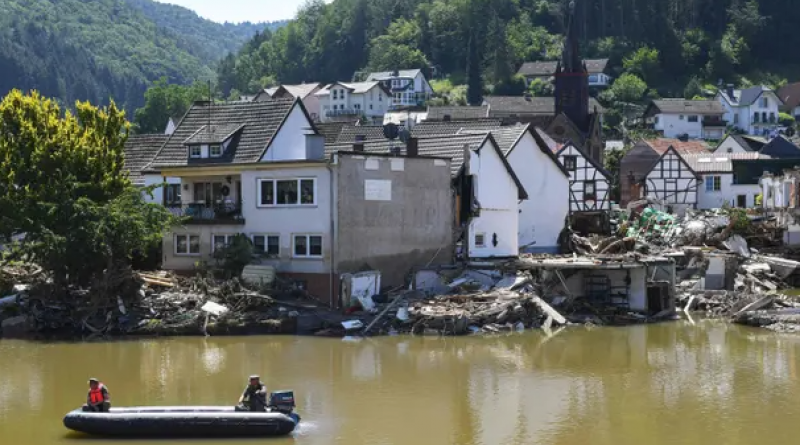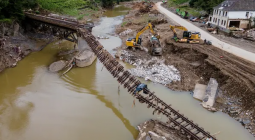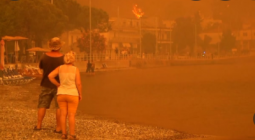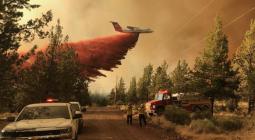Reporting on the climate crisis: ‘For years it was seen as a far-off problem’

Our correspondent talks to her predecessor about how global heating went from a ‘slow burn’ to the biggest story of all
Devastating floods across Europe, killer heatwaves in Canada, wildfires across the US. Extreme weather has hit the headlines across the world in the past few weeks, and even climate scientists have been shocked by its severity and extent, which they say is clearly linked to human activity in heating the planet.
It all comes as no surprise to Paul Brown, the Guardian’s former environment correspondent. He was warning of the consequences of climate change nearly four decades ago, from the mid-1980s, as scientists began to raise the alarm over greenhouse gas emissions and their potential impact.
The big problem then with writing climate news was that nearly all of it was based on predictions of the long-term future. “When I was writing, we were talking about what would happen 50 years away,” he said. “It needed all our ingenuity to make it sound like a news story, because people find prospects that far into the future quite boring.”
Climate change for years was seen as a “slow burn”, a far-off prediction that changed little day-to-day, and so was unsuitable for the daily news diet of most media outlets. That perception, that the climate is not really news, has been blown apart by the rise in extreme weather that has made the climate crisis unignorable. The emergency is now on the front pages of newspapers around the world – and the price of those decades of ignoring warnings, and dismissing predictions as alarmist, is now being paid.

Yet in those early days, governments had begun to grapple with the problem in what now seems a prescient and even urgent fashion. In 1988, they set up a body of leading international scientists to assess our knowledge of climate science, and just four years later in 1992 signed the first global climate treaty. It looked as if the looming crisis was about to be solved.
That optimism of the early 1990s appeared justified – governments were fresh from wrapping up a global treaty, in 1987, that had resolved another existential threat. The ozone layer had been discovered in the mid-1980s to be rapidly thinning and a hole was growing in the protective “skin” of the planet. It was caused by chemicals commonly used as refrigerants, which the Montreal Protocol phased out.
Brown covered the signing of the treaty. He then had to persuade a reluctant newsdesk that it was worth sending him to the Earth Summit in Rio de Janeiro in 1992, at which the UN Framework Convention on Climate Change (UNFCCC) was forged. “There was a recession in the early 1990s and people were losing their houses and jobs, so interest in the environment went downhill a bit,” he said.
Brown attended the first 10 Conferences of the Parties (Cops) under the UNFCCC, parent treaty to the 1997 Kyoto protocol and the Paris climate accord of 2015; I have attended 14 out of the last 16 Cops, since taking on the role of an environment correspondent in 2004, first at the Financial Times and since 2011 at the Guardian.
This year’s Cop26, in Glasgow this November, will be one of the most important of all: after decades of insufficient action, while greenhouse gas emissions have steadily risen, scientists are now sure that temperature rises of more than 1.5C would cause devastation, and that carbon emissions must be halved by 2030 to stay within that threshold. That makes this decade crucial, and at Cop26 governments must come up with plans for cutting emissions sharply in the next 10 years.
When Brown started out in the environment role – he had already been a journalist for two decades by the time he joined the Guardian, starting out as an apprentice on the East Grinstead Courier in 1961 – the climate was just one consideration among other planetary issues that seemed more pressing, such as pollution and nuclear energy. Starting at the Guardian on 1 January 1981, after two years in the feverish tabloid atmosphere of the Sun (“you learned to keep a toothbrush in your pocket, because every day when you went into work you didn’t know where you might be sent and where you might end up that night”), he quickly found environment stories most appealing.
Brown still needed his toothbrush: in 1983, he went to report on a Greenpeace blockade of a pipeline at Sellafield, the UK nuclear plant, which allowed discharges of radioactive waste into the North Sea. “At that time, the UK was labelled the dirty man of Europe,” he noted, for the pollution that was poured into the sea from sewage outlets around the coast, the coal-burning that caused acid rain, and other pollution.
Sewage is still a problem for the UK’s now-privatised water companies – investigations by Sandra Laville, another of Brown’s successors, have revealed the shocking extent of the problem, raising a national outcry.
In 1988, Brown was sent to Antarctica, reporting from a Greenpeace base. For three months, he kept in touch via then cutting-edge technology, in the form of a clunky satellite phone – a key selling-point for his visit to the technology-mad editor at the time, Peter Preston. It enabled the paper to run his stories with a unique dateline: Paul Brown in Antarctica. “They loved that dateline!” he recalls.
He was formally made environment correspondent in 1989, and continued until his retirement from the Guardian in 2005. Over that period, Brown sometimes struggled to get stories past a newsdesk that often seemed more interested in sport or daily political wrangling. But he got strong backing when in the late 1990s the Guardian undertook in-depth research on what stories readers spent most time with. “It turned out that environment stories were the second most read, after medical stories,” he said. “It was much to their surprise, but it certainly made a substantial difference to the editors’ attitude.”
That is mirrored today, when environment stories are some of the best-read on the Guardian’s website and frequently cited by readers, subscribers and supporters as a key reason for their enthusiasm for the Guardian. The environment team has now increased to seven members in London alone, with additional journalists dedicated to the Age of Extinction and Seascape, along with colleagues around the world.
Brown is still a regular contributor to the Guardian, in the much loved Weatherwatch and Specieswatch columns. The job of environment correspondent still involves warnings about the future, but climate breakdown and the crisis in nature can no longer be regarded as “slow burn” – they are emergencies happening now and must be treated as such.
As Brown tells me wryly: “The fact that catastrophic climate change is happening on a weekly basis makes your job a lot easier today.” We would all rather that were not so.
26 August 2021
The Guardian




